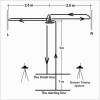Acute effects of prolonged intermittent low-intensity isometric warm-up schemes on jump, sprint, and agility performance in collegiate soccer players
- PMID: 26060336
- PMCID: PMC4447758
- DOI: 10.5604/20831862.1140427
Acute effects of prolonged intermittent low-intensity isometric warm-up schemes on jump, sprint, and agility performance in collegiate soccer players
Abstract
The aim of the present study was to compare the effects of different warm-up interventions on jump, sprint and agility performance in collegiate soccer players. Twenty-one healthy male college soccer players (age: 20.14 ± 1.65 years; body height: 179.9 ± 8.34 cm; body mass: 74.4 ± 13.0 kg; % body fat: 9.45 ± 4.8) participated in the study. Subjects underwent four different randomized warm-up protocols separated by at least 48 hours. The warm-up schemes were: 1. no conditioning contraction protocol (NCC); 2. dynamic stretching (DS); 3. prolonged intermittent low-intensity isometric exercise (ST); and, 4. ST with an additional external load equal to 30% of body weight (ST + 30% BW). All interventions were preceded by a general warm-up. Results from one-way repeated measures ANOVA demonstrated a significant difference in countermovement jump (CMJ) at F(3,60) = 10.2, ηρ(2) = 0.337, p < 0.01. Post hoc analysis revealed a significant difference in CMJ performance in DS when compared to NCC and ST + 30% BW. No significant difference in CMJ was observed between DS and ST. CMJ scores in NCC, ST, and ST + 30% BW were non-significant. There was a significant difference in speed; F(3, 60) = 6.61, ηρ(2) = 0.248, p < 0.01. Post hoc analysis revealed significantly better time in DS than NCC and ST. However, no difference in speed was observed between DS and ST + 30% BW. Similarly, speed was similar in NCC, ST and ST + 30% BW. A significant difference in agility performance was also observed; F(3, 60) = 24.1, ηρ(2)= 0.546, p < 0.01. Post hoc analysis revealed significantly greater performance gains in DS than NCC. No significant difference in agility was observed in DS, ST and ST + 30% BW. In conclusion, a prolonged intermittent low-intensity isometric protocol using bodyweight only showed similar benefits with dynamic stretching in countermovement jump performance. When the same isometric condition with additional load equal to 30% of bodyweight was applied, effects in speed and agility were similar to dynamic stretching.
Keywords: conditioning contraction; countermovement jump; external load; fatigue; post activation potentiation.
Figures






References
-
- Gelen E. Acute effects of different warm-up methods on jump performance in children. Biol Sport. 2011;28(2):133–138.
-
- Hedrick A. Physiological responses to warm-up. J Strength Cond Res. 1992;14(5):25–27.
-
- Gray S, DeVito G, Nimmo M. Effect of active warm-up on metabolism prior to and during intense dynamic exercise. Med Sci Sports Exerc. 2002;34(12):2091–2096. - PubMed
-
- Starkie RL, Hargreaves M, Lambert D, Proietto J, Febbraio M. Effect of temperature on muscle metabolism during submaximal exercise in humans. Exp Physiol. 1999;84(4):775–784. - PubMed
-
- Dawes J, Roozen M. 2012. Developing Agility and Quickness. NSCA - National Strength & Conditioning Association, Human Kinetics, Champaign, IL.
LinkOut - more resources
Full Text Sources
Other Literature Sources
Miscellaneous
